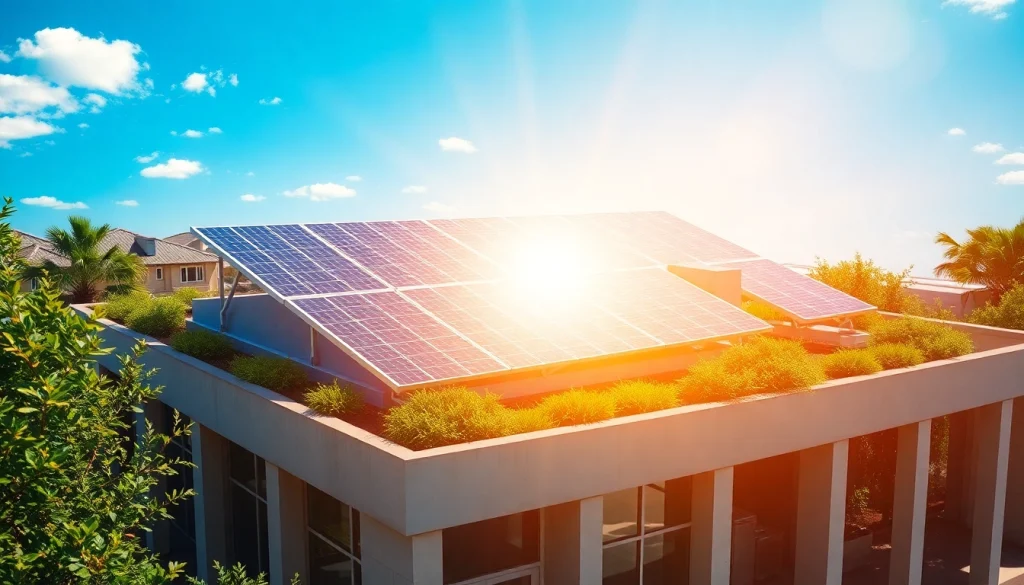
Understanding Commercial Solar: Benefits for Businesses
What is Commercial Solar?
Commercial solar refers to the deployment of solar energy systems in business settings, enabling enterprises to harness the power of the sun to generate electricity. These systems can be installed on rooftops, parking lot canopies, or in solar farms dedicated entirely to large-scale energy production. Unlike residential solar systems, which are typically designed for individual households, commercial solar projects can vary greatly in size and capacity, ranging from small installations of a few kilowatts to large setups generating multiple megawatts of power.
Businesses of all sizes are tapping into this renewable energy source not only to reduce their carbon footprint but also to achieve significant cost savings on their electricity bills. As more companies seek sustainable practices, the popularity of commercial solar is set to rise, transforming how businesses function in an environmentally-conscious marketplace.
Key Advantages of Commercial Solar Systems
Adopting commercial solar offers several key advantages, making it a compelling choice for many businesses:
- Cost Savings: One of the most immediate benefits of commercial solar is the potential reduction in energy bills. Depending on the size and type of the installation, businesses can save up to 70% on their electricity costs over time.
- Energy Independence: By generating their own electricity, companies protect themselves from fluctuations in energy prices and can plan more effectively for future energy costs.
- Tax Incentives: Various government incentives and tax credits significantly reduce the initial investment burden. In many cases, businesses can benefit from accelerated depreciation and federal tax credits, such as the Investment Tax Credit (ITC).
- Enhanced Corporate Image: Demonstrating a commitment to sustainability can enhance a company’s brand, attracting environmentally-conscious consumers and investors.
- Job Creation: Commercial solar projects can create numerous jobs in installation, maintenance, and manufacturing, contributing to local economies.
Common Misconceptions
Despite the numerous advantages, several misconceptions about commercial solar persist:
- High Upfront Costs: While the initial investment can be considerable, the combination of incentives and the long-term savings often make commercial solar a financially smart decision.
- Space Limitations: Some businesses believe they lack the space for solar installations. However, options like solar carports and solar farms can be tailored to fit different space constraints.
- Complex Maintenance: Modern solar systems require minimal maintenance. With advancements in technology, most systems can operate efficiently with routine inspections and cleaning.
Cost Analysis: Is Commercial Solar Worth the Investment?
Understanding Initial Costs
Commercial solar installations do involve upfront expenses, which may include equipment, installation labor, legal fees, and maintenance setup. The initial costs of solar panels—particularly high-efficiency models—can range significantly based on the system size and site conditions. Businesses should conduct a detailed cost analysis considering all variables, including the size of the installation, regional pricing, and specific energy needs.
On average, a commercial solar system can cost between $140,000 to $500,000. However, the cost per watt continues to decline, making solar a more attractive investment. Businesses must also factor in financing options such as solar loans or Power Purchase Agreements (PPAs), which can mitigate initial financial burden.
Long-term Financial Benefits
While the initial investment may appear daunting, the long-term benefits often justify the costs:
- Reduced Operating Costs: By generating electricity on-site, businesses decrease their reliance on grid power, resulting in noticeable monthly savings.
- Return on Investment (ROI): Depending on the system scale, ROI can be realized within 5 to 10 years, and the systems can last 25 years or more, generating free electricity after payback.
- Increased Property Value: Properties equipped with solar energy systems often see a rise in value due to lowered operational costs and a more sustainable appeal.
Incentives and Tax Benefits
In the U.S., several incentives can aid in off-setting the costs of commercial solar systems:
- Investment Tax Credit (ITC): Businesses can deduct a significant percentage of the cost of installing a solar energy system from their federal taxes. Currently, the rate is 26% until the end of 2023, gradually stepping down afterward.
- Depreciation Benefits: Under the Modified Accelerated Cost Recovery System (MACRS), businesses can depreciate the value of solar systems over five years, thereby reducing taxable income.
- State and Local Incentives: Various states offer additional rebates, grants, and property tax exemptions to further incentivize the adoption of solar energy solutions.
Finding the Right Commercial Solar Provider
What to Look For in a Provider
Selecting a commercial solar provider is a crucial step in the installation process. Here are key factors to consider:
- Experience and Expertise: Opt for a provider with a solid track record and extensive experience in commercial solar installations. Assess their portfolio to ensure they have dealt with projects similar to yours.
- Certifications and Credentials: Look for providers that hold necessary licenses and certifications. Certifications from the North American Board of Certified Energy Practitioners (NABCEP) can be an indicator of quality.
- Customer Support: A reliable provider should offer comprehensive customer support, including design assistance, installation, maintenance, and monitoring services.
Evaluating Customer Reviews
Consumer feedback and reviews can provide significant insights when assessing a solar company. Check online platforms for testimonials and ratings. Pay attention to remarks about the quality of service, product performance, and responsiveness. Engaging with previous customers via online forums or local business groups can also offer valuable perspectives.
Understanding Warranties and Support
Before committing to a provider, it is vital to understand the warranties associated with both equipment and installation:
- Equipment Warranties: Solar panels typically come with warranties ranging from 10 to 25 years, covering performance and defects. Inquire about the specifics of these warranties.
- Installation Warranties: Reputable installers should also offer warranties on their workmanship, ensuring that if any issues arise post-installation, you will receive support without incurring additional costs.
Installing Commercial Solar: A Step-by-Step Guide
Initial Consultation and Site Assessment
The installation process begins with an initial consultation where the solar provider assesses your needs and objectives. This is typically followed by a thorough site assessment where technicians evaluate:
- The roof or ground space available for installation
- Sunlight exposure and shading
- Building structural integrity to support solar installations
- Integration with existing electrical systems
Designing a Custom Solution
Following the assessment, the solar provider develops a customized design tailored to the specific energy needs of the business. This stage includes:
- Determining the appropriate size and type of solar system
- Calculating potential energy savings and return on investment
- Obtaining necessary permits and approvals from local authorities
Installation Process Explained
The installation process is typically structured as follows:
- Preparation: The installation team prepares the site, ensuring all safety standards are adhered to and scaffolding or cranes are set up as needed.
- Installation: The actual installation involves mounting the solar panels, wiring, connecting to the inverter, and integrating with the building’s electrical system.
- Inspection: Post-installation, a thorough inspection is conducted to ensure everything complies with local codes and regulations.
- Activation: Once everything is approved, the system is activated, allowing the business to start generating its own solar energy.
Measuring Success: Performance Metrics for Commercial Solar
Key Performance Indicators (KPIs)
Evaluating the success of a commercial solar system involves specific Key Performance Indicators (KPIs), including:
- Energy Production: Monitoring the amount of energy produced over time to compare with estimated outputs.
- Cost Savings: Tracking the reduction in electricity expenses to measure return on investment.
- System Efficiency: Calculating the percentage of energy generated relative to the total sunlight available, which helps identify performance issues.
Continuous Monitoring Solutions
Many commercial solar systems come equipped with monitoring technology, allowing businesses to visualize energy production in real-time. This technology offers:
- Alert notifications for any potential system faults
- Data for ongoing performance assessment and optimization
- The ability to forecast energy production during different seasons based on historical data
Adjusting Strategies for Optimal Results
To maximize the benefits of a commercial solar installation, ongoing maintenance and strategic adjustments may be necessary. This can include:
- Regular cleaning and maintenance of solar panels to ensure efficiency
- Adjusting energy usage patterns to align with peak solar production hours
- Upgrading system components when technology improves or as energy needs change




